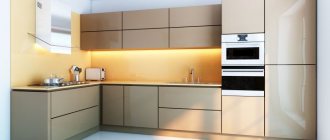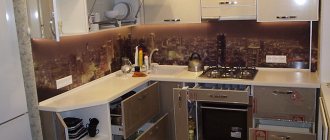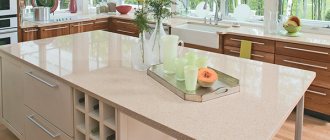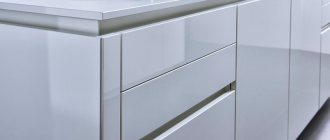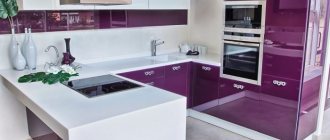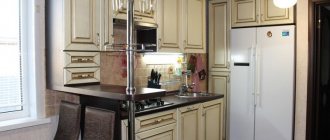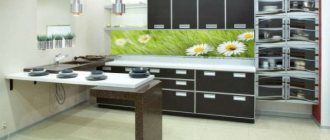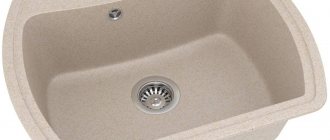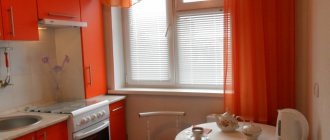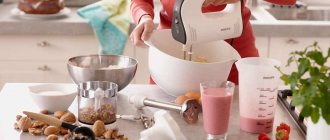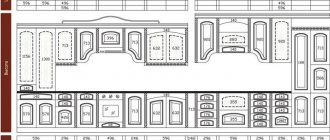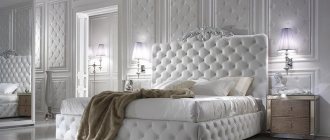A modern kitchen set should be beautiful, functional and reliable. When choosing furniture for the kitchen, it is important to familiarize yourself with the facades. In particular, it is necessary to obtain more information about their characteristics, production conditions and care features.
We will look at the classic options for materials that are used today for the manufacture of cabinets, doors and the external component of the kitchen composition. They all differ in their external characteristics and performance characteristics. Their features, care rules and various decoration variations will allow you to choose the most optimal option for yourself. At the same time, you will be confident in the quality, impeccable appearance and long service life of the facade material.
Primary requirements
When choosing a material, the following criteria must be taken into account
- Moisture resistance. In cooking areas there is always high humidity and sudden temperature changes.
- Wear resistance. Materials must withstand increased loads and at the same time be suitable for daily use.
- Strength. Kitchen facades should not deform, swell, or lose their shape over time.
- Easy to maintain. The surface should be easy to clean and wash. Removing grease and other types of contaminants should not be particularly difficult.
- Long service life. Durability directly depends on performance characteristics.
Types and shape of facades
Today the following types of facades are distinguished:
- Blinds - are a canvas in the form of blinds or grilles. Provide the best air exchange and extend the service life of the material.
- Frame, paneled - include panels made of wood, chipboard, MDF, plywood and other materials.
- Solid - the most expensive type of facade, which is made from natural solid wood. Usually impregnated with adhesive components to achieve greatest strength.
In accordance with the shapes of the finished kitchen set, today there are the following configurations of facades:
- Angular. Semicircular facades, which are used for L-shaped sets.
- Direct. Standard classic version. It is a smooth canvas without bends.
- Radial. Unique designs that can have a convex or concave shape. They are used mainly for non-standard creative design of kitchen interiors.
PVC coated MDF
They have the same advantages as MDF base. The covering layer is a polymer film, which can have any color, surface type (matte/glossy). This coating is much simpler and cheaper compared to painting. In addition, it can look like wood, stone, granite surfaces, as well as ceramics.
MDF coated with PVC film is the most common option on the market.
Photo from source: decolabs-home.arxip.com
Countertop Cedar 713/1 Black granite
Advantages
- low price;
- a wide variety of colors and patterns;
— regardless of the standard or non-standard execution of kitchen elements, the price does not change;
— does not wear out, is resistant to aggressive environments.
Flaws
— the drawing that is applied to the film fades under the rays of the sun;
- a strong difference between imitation and natural materials;
— there is a risk of the film peeling off from the base under the influence of high temperatures. High-risk areas: cabinets located close to the oven, dishwasher, electric kettle;
- impossibility of making restoration.
Facade materials: their pros and cons
For the production of kitchen facades, both natural and modern time-tested materials are used. Among them we can highlight natural wood, plastic, glass, chipboard, MDF, chipboard. The unique manufacturing technology affects their service life. The higher the wear resistance, the longer it will retain its impeccable appearance.
Veneer, enamel and various films are widely used today as auxiliary materials. They have increased moisture resistance and are not afraid of external factors. Even inexpensive materials with specialized coating can last for many years. After weighing all the advantages and disadvantages, you can choose the most suitable material both in terms of technical characteristics and cost.
Wooden facades
Natural wood facades are quite often used to equip kitchen units in a classic style. At the very beginning, an appropriate array of larch, oak and other types of wood is selected. The wood is dried to prevent further deformation. The finished dried wood is sawn according to the specified dimensions. Decorative elements are formed separately. In order to protect wood from external factors, it is treated with an antiseptic, varnished or painted.
The undeniable advantages of wooden facades include rich appearance, maximum service life, good strength and wear resistance. To care for natural wood facades, it is recommended to use gentle household chemicals without abrasive particles. It is recommended to periodically treat the surface with polish and wax.
Natural veneer facades
Veneered facade systems are made from chipboard and MDF. In this case, the canvas is covered with a thin layer of wood by gluing under high temperature. After drying, the edge is covered with a special film. The finished façade structure is quite similar in appearance to natural wood. At the same time, it is much cheaper than facades made of natural wood.
The only drawback of veneer facades is their limited service life due to the multi-layer structure. It is best to purchase veneer facades from trusted manufacturers who fully comply with production technology.
Glass facades
When arranging kitchens today, frameless and framed glass facades are used. The first ones are a completely glass sheet that requires processing. Framed ones are usually framed with a frame made of wood, aluminum and other modern materials.
Today, three types of glass are used in the production of facade glass:
- Tempered. Manufactured at high temperatures. Its advantages include the fact that under mechanical stress and stress it does not crumble into sharp fragments and is completely safe.
- Laminated. Facade material is made from several layers of glass at high temperatures. The finished products have increased strength and are designed for a long service life in any operating conditions.
- Float glass. The material has minimal impact resistance. Made from glass under the influence of high temperatures, it is used mainly for framed facades.
Glossy enamel facades
MDF facades with enamel coating look very beautiful, presentable and stylish. They are perfect for interior decoration in modern and high-tech style. The production technology consists of several stages and requires a professional approach. To ensure that the final product is of high quality, the following procedures are performed:
- the surface of the canvas is primed,
- Using special equipment, paint is applied in several layers,
- A protective coating is applied, most often it is varnish.
The enamel surface looks beautiful and impressive and does not have any foreign unpleasant odor. The disadvantages of this facade coating include the fact that fingerprints remain on it and any dirt is visible. To care for the facade, a soft sponge and special household chemicals without abrasives can be used.
MDF facades with PVC coating
Today, modern budget materials are very popular, which are not much inferior in their external indicators and performance characteristics to facades made of natural wood and veneer. PVC film provides excellent protection against high humidity conditions and any mechanical impact.
The production technology consists of the following stages
- The slab is cut to appropriate dimensions.
- Edge processing is carried out if necessary.
- High-quality grinding and cleaning of workpieces for facade manufacturing.
- Special hot melt adhesive is applied for the best adhesion.
- Gluing PVC film using a special press.
- Checking the finished product, removing excess film and glue.
Time-tested production technology allows us to guarantee impeccable quality of the finished façade structure. Over time, the film will not peel off even in conditions of excessive humidity. To clean the surface, you must use ordinary household chemicals. If necessary, you can always update the facade using a new film.
MDF facades with plastic
In the manufacture of kitchen furniture, plastic-coated canvases are often used. Plastic finishing gives the structure an impeccable appearance and ensures a long service life of the material. The production technology includes the following stages:
- Gluing special kraft paper to the surface of the canvas for best adhesion.
- Connecting plastic to a workpiece using specialized equipment.
- Coating the facade with a special protective layer and acrylic resins.
Among the advantages are high wear resistance, durability and the ability to use almost any cleaning products. The disadvantages include the high cost; not everyone can afford such facades.
Facades with lamination
Today, laminated chipboard and MDF facades are becoming increasingly popular. They are quite practical, can perfectly imitate the color of natural wood, and are designed for a long service life. They are made as follows:
- The base surface is primed.
- The slab is drying.
- Laminated paper is glued to the surface of the canvas.
Highly efficient production technology ensures increased moisture resistance and mechanical stability. The finished product has an impeccable appearance. During operation, the use of fine abrasive chemicals is allowed. Among the advantages can be highlighted - low cost.
Frame facades using MDF profiles
An original canvas with impeccable aesthetic and functional characteristics. The structure consists of an internal canvas and a frame. The frame is located around the perimeter of the canvas, and the base can be made in various design variations. Grills, glass, MDF, chipboard, glass, and plastic can be used as internal filling.
During the manufacturing process, special recesses are formed inside for reliable fixation of the canvas. Fastening is done using staples. The angle between elements is usually 46 degrees. Among the advantages are a presentable appearance and the ability to implement various design ideas. The disadvantages include the difficulty of maintenance, since it is not always easy to remove grease and various contaminants from glass surfaces.
Facades with acrylic
Acrylic material is considered quite moisture resistant and is widely used in furniture production. The manufacturing process is as follows: a thin sheet of acrylic is glued to an MDF or chipboard board, then the finished structure is pressed. At the final stage, the ends of the facade are covered with edges. Acrylic coating can be applied on one side or on both sides.
Among the advantages of this coating are rich brightness and a brilliant effect under various types of lighting, as well as good moisture resistance and long service life. The disadvantages are that any dirt is clearly visible on glossy surfaces, which is why they require constant care.
Facades with aluminum frames
Aluminum gives furniture compositions lightness, grace and impeccability. The presence of an aluminum edge provides additional protection of the canvas from external factors. Aluminum frames are not afraid of various chemicals. In the production of facades, a sheet of MDF or glass is glued to an aluminum frame; it usually has a U-shape.
Weight advantages include durability, reliability, aesthetics and attractiveness. The presented kitchen sets are perfect for interiors in modern, high-tech and light urban styles. And the most important advantage is that such facades do not have to be updated after several years. The aluminum edge provides adequate protection.
How does MDF differ from chipboard and solid wood?
Compared to particle board, MDF provides opportunities for the manufacture of facades of original shapes (convex/concave). The chipboard surface is a smooth film with a textured pattern. Furniture made from medium-density fiberboard is the base, which, along with PVC and paper-resin film, can be finished with plastic, veneer, and coated with paint. Yes, it is more expensive than front panels made of chipboard. But at the same time it is distinguished by higher quality and safety of use.
Unlike wood, facades with a fiberboard base are resistant to UV radiation. They do not require complex care. It is enough just to wipe the surfaces from time to time with a soft cloth soaked in a mild soap solution. Yes, they don't look so solid. However, with modern finishing and decorating technologies, you will not have any problems in realizing any design idea.
Types of fittings for facades
In accordance with the specification of the façade itself, the component elements are divided into the following types:
- Transformer loops. Allows doors and sashes to open 150 degrees or more.
- Double-sided loops. A metal structure consisting of two plates fastened together with a pin.
- Overhead loops. Mainly used for single-door bedside tables.
- Semi-overhead. They are used mainly for double-leaf doors, when two leaves are placed on one end part at once.
- Microlifts. The modern type of fittings, operating on the gas lift principle, ensures smooth opening and closing.
- Guides. Used to open drawers. They are most popular with door closers; they provide the required comfort.
- Secret loop. Consists of two parts, a cylinder with a protruding element. When closing, the presented elements are included and nested within each other. This contributes to the tight connection of the sash to the base.
Modern overhead handles can have different shapes depending on the design and customer preferences. Fittings in the form of buttons, rings, drops are increasingly in demand; staples and roof rails are also popular. When decorating a kitchen set in a classic design, mortise handles are used, which look very aesthetically pleasing and beautiful.
Style and color schemes of facades
When choosing furniture for the kitchen, in addition to the facade, material and components, it is necessary to take into account compatibility with the interior. The following options look great:
- Modern and high-tech. Silver, grey, bright glossy surfaces with aluminum edges.
- Provence. Here it is best to give preference to light-colored facades with frosted glass or grilles and blinds.
- Modern style. The best option would be light green, beige, light purple and other similar shades.
- Classic. Facades in dark brown or light brown will look decent.
When choosing colors and formats, it is best to consult with experienced designers. After all, you want your kitchen furniture to be not only practical, reliable and functional, but at the same time to fit perfectly into the overall interior.
Let's summarize
Today the market offers a rich variety of materials for kitchen sets. When choosing, be sure to take into account quality, originality of execution, style and ease of maintenance. For example, dust and dirt from glass surfaces must be removed daily, but from MDF and wood 1-2 times a week is enough. Before choosing a suitable facade, it is best to familiarize yourself with samples and consult with experienced specialists. A balanced approach will help you find the ideal solution and the best fittings for your furniture.
Summary
The ideal kitchen set is beautiful, functional and durable. To make it this way, it is important to choose the right materials. Here are the components of a good headset:
- Frame made of laminated chipboard (with high-quality glued PVC edge).
- Tabletop made of artificial stone or laminated slab.
- Facades: all products of decent quality are good (except for budget wood and low-quality “film”).
- Branded fittings with closers.
- A professional designer who will create a harmonious and functional project, taking into account all your wishes.
